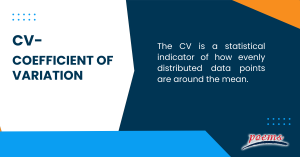Coefficient of Variation (CV)
Table of Contents
Coefficient of variation
A word widely used in statistics is the coefficient of variation. In statistics, nothing should be taken at face value. The information might point to one thing, but a more thorough investigation might show something else.
Experts use a statistical metric known as the coefficient of variation to track changes in data over time. This indicator can also determine the financial risk and reward for investment operations. The coefficient of variation (CV) can be determined using a straightforward formula.
What is CV?
The CV is a statistical indicator of how evenly distributed data points are around the mean.
The measure frequently contrasts the data dispersion between several data series. The CV offers a very straightforward and rapid method to compare several data series, in contrast to the standard deviation, which must always be viewed in the context of the data mean.
The CV is crucial when choosing investments in finance. From a financial standpoint, the financial statistic represents the risk-to-reward ratio, where the volatility reflects the danger of an investment and the mean reward.

Understanding CV
The CV demonstrates the degree of data variability in a sample compared to the population means. The CV in finance enables investors to assess how much risk or volatility is assumed relative to the return anticipated from investments.
The better the risk-return tradeoff, the lower the ratio of standard deviation to mean return should be due to the CV formula. However, for example, quartile, quintile, or decile CVs can be used to examine variance around the median or 10th percentile. They are most frequently employed to study dispersion around the mean.
Several disciplines, including chemistry, engineering, physics, economics, and neuroscience, use the CV. Economists use the risk/reward ratio to quantify economic inequality and assist in investment decision-making. It is frequently used outside of finance to check the accuracy of a certain procedure and achieve the ideal balance.
CV formula
The CV formula computes a ratio to indicate the dispersion of your values around the mean using the standard deviation and mean of your sample data. The fundamental formula for figuring out the CV in statistical analysis is:
CV = (standard deviation/sample mean) x 100
Many experts simplify the CV formula for business purposes—like financial calculations—to apply to financial measurements like investment returns, capital gains, risk, and investment volatility. To determine the CV in terms of financial risk and reward, many analysts may also use the following formula:
CV =( volatility/expected return) x 100
Advantages of CV
The advantages of the CV are as follows:
- The CV, independent of units, depicts the link between standard deviation and mean.
- For contrasting data sets with various units or drastically differing means, the CV may be helpful. That includes when investments are chosen using the risk/reward ratio. Investors who want to take on risk could invest in assets with historically high volatility.
- Choosing the best options available becomes simple if you know how to compute the CV. This idea is helpful when a business scales up its operations because of the significant expense involved. Some of the company’s staff members could need to be let go. The CV idea aids in choosing which department should be eliminated.
- It is used to compare distributions because it is a non-dimensional number.
Disadvantages of CV
The disadvantages of the CV are as follows:
- The CV will approach infinity when the mean value is near zero, making it sensitive to even slight changes in the mean. It is frequently the case if the values come from a scale other than a ratio.
- Unlike the standard deviation, it is not used directly to create confidence intervals for the mean.
- When stated in its logarithmic form, calculating any variable’s CV is pointless. The reason is that the log of 1 is equal to 0. Hence, all we are doing is changing the definition of zero.
- Since CVs are independent of the number of duplicates and the confidence in the mean increases as the number of repetitions increases, they are not the optimum indicator of measurement certainty when the number of replicates changes among samples. It is advised that standard error in percent is preferable in this situation.
Frequently Asked Questions
The range of values in a dataset is measured by the standard deviation and the CV. The standard deviation quantifies the standard deviation of the average value from the mean. The standard deviation means the coefficient of variation gauges ratio.
The CV, for instance, is employed in finance for comparing the mean expected return on an investment to the anticipated standard deviation of the investment.
The CV of observations describes the degree of variation within a population without regard to the absolute values of the data. The CV is most frequently used to evaluate a technique’s accuracy. It is also used to compare the variability of measurements taken in various units and as a metric of variability when the standard deviation is proportionate to the mean.
Example of a CV:
Consider the following data set: [80, 90, 100]. The population’s standard deviation is 8.165, and the mean is 90. The variation coefficient is 0.09. The CV is 9% as a percentage.
Generally, a CV of 20 to 30 is considered appropriate, whereas a CV of more than 30 is considered unsatisfactory.
The formula to calculate CV is:
CV = (Standard Deviation / Mean) * 100.
Related Terms
- Mark-to-market
- Federal Open Market Committee
- FIRE
- Applicable federal rate
- Assets under management
- Automated teller machine
- Central limit theorem
- Balanced scorecard
- Analysis of variance
- Annual percentage rate
- Double Taxation Agreement
- Floating Rate Notes
- Average True Range (ATR)
- Constant maturity treasury
- Employee stock option
- Mark-to-market
- Federal Open Market Committee
- FIRE
- Applicable federal rate
- Assets under management
- Automated teller machine
- Central limit theorem
- Balanced scorecard
- Analysis of variance
- Annual percentage rate
- Double Taxation Agreement
- Floating Rate Notes
- Average True Range (ATR)
- Constant maturity treasury
- Employee stock option
- Hysteresis
- RevPAR
- REITS
- General and administrative expenses
- OPEX
- ARPU
- WACC
- DCF
- NPL
- Capital expenditure (Capex)
- Balance of trade (BOT)
- Retail price index (RPI)
- Unit investment trust (UIT)
- SPAC
- GAAP
- GDPR
- GATT
- Irrevocable Trust
- Line of credit
- Creative Destruction (CD)
- Letter of credits (LC)
- Statement of additional information
- Year to date
- Certificate of deposit
- Price-to-earnings (P/E) ratio
- Individual retirement account (IRA)
- Quantitative easing
- Yield to maturity
- Rights of accumulation (ROA)
- Letter of Intent
- Return on Invested Capital (ROIC)
- Return on Equity (ROE)
- Return on Assets (ROA)
Most Popular Terms
Other Terms
- Physical ETF
- Initial Public Offering
- Buyback
- Secondary Sharing
- Bookrunner
- Notional amount
- Negative convexity
- Jumbo pools
- Inverse floater
- Forward Swap
- Underwriting risk
- Reinvestment risk
- Final Maturity Date
- Payment Date
- Secondary Market
- Margin Requirement
- Pledged Asset
- Yield Pickup
- Subordinated Debt
- Trailing Stops
- Treasury Stock Method
- Stochastic Oscillator
- Bullet Bonds
- Basket Trade
- Contrarian Strategy
- Exchange Control
- Notional Value
- Relevant Cost
- Dow Theory
- Speculation
- Stub
- Trading Volume
- Going Long
- Pink sheet stocks
- Rand cost averaging
- Sustainable investment
- Stop-limit sell order
- Economic Bubble
- Ask Price
- Constant prepayment rate
- Covenants
- Stock symbol
- Companion tranche
- Synthetic replication
- Bourse
- Beneficiary
- Witching Hour
- Widow and Orphan stock
- Public Float
- Closing Price
Know More about
Tools/Educational Resources
Markets Offered by POEMS
Read the Latest Market Journal

Back in Business: The Return of IPOs & Top Traded Counters in March 2024
Start trading on POEMS! Open a free account here! At a glance: Major indices continue...

Weekly Updates 15/4/24 – 19/4/24
This weekly update is designed to help you stay informed and relate economic and company...

From $50 to $100: Unveiling the Impact of Inflation
In recent years, inflation has become a hot topic, evoking strong emotions as the cost...

Japan’s Economic Resurgence: Unveiling the Tailwinds Behind Nikkei 225’s Record Leap
Source: eSignal, Intercontinental Exchange, Inc. In the heart of Japan’s economic landscape, the Nikkei 225...

Weekly Updates 8/4/24 – 12/4/24
This weekly update is designed to help you stay informed and relate economic and...

What Makes Forex Trading Attractive?
In a world where the click of a button can send goods across oceans and...

Weekly Updates 1/4/24 – 5/4/24
This weekly update is designed to help you stay informed and relate economic and company...

How to soar higher with Positive Carry!
As US Fed interest rates are predicted to rise 6 times this year, it’s best...












